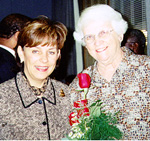Medical technology program celebrates
by Ruby SonnettCollege of Health Professions
On Nov. 27, the medical technology (MT) professional option of the Clinical Laboratory Science (CLS) program in the College of Health Professions celebrated two milestones.
 Members
of the 2002 graduating class are: Karen Denault, Cheryl Boyd, Joielle Knightner,
Gina Webb, Amber Johnson, Shola Gates, Heidi Lee, Robert Haynes, Julie
Miller, LaSheena Washington, J.T. Durall, Jamie Anderson, Antionette Bennett
and Eric Lee. Faculty pictured are: Deborah Keil, Ruby Sonnett, Cynthia
Karr and Janice Hundley.
Members
of the 2002 graduating class are: Karen Denault, Cheryl Boyd, Joielle Knightner,
Gina Webb, Amber Johnson, Shola Gates, Heidi Lee, Robert Haynes, Julie
Miller, LaSheena Washington, J.T. Durall, Jamie Anderson, Antionette Bennett
and Eric Lee. Faculty pictured are: Deborah Keil, Ruby Sonnett, Cynthia
Karr and Janice Hundley.
First, the 2002 graduate students were awarded a MUSC Certificate of Completion, marking the completion of the professional component (first year) of the Master of Science in CLS program.
In conjunction with the individual accomplishments of its students, the program celebrated its 75th anniversary. The program graduated its first student, Lois Doscher, in 1926, and, since that time, has produced more than 850 graduates.
 Mary
Eileen Leonard, right, is recognized for her significant contributions
to the program. Pictured with Leonard is Dr. Danielle Ripich, professor
and dean, College of Health Professions.
Mary
Eileen Leonard, right, is recognized for her significant contributions
to the program. Pictured with Leonard is Dr. Danielle Ripich, professor
and dean, College of Health Professions.
Alumni in attendance shared stories about the changes that have occurred during this extensive history. One alumnus, Mary Eileen Leonard, was recognized for her significant contributions to the program and her unique historical perspective since she has been a working professional for 55 of those 75 years.
As one of the oldest MT programs in the United States, it has changed dramatically, particularly during the past 25 years.
Improvements in technologies have raised the productivity of the current clinical staff, and advances in science have increased the volume and complexity of health care services, creating a need for additional graduates with more sophisticated skills.
For example, not too long ago there were only a few coagulation assays, such as the prothrombin time (PT) and activated partial thromboplastin time (APTT), which were primarily used for monitoring patients on anticoagulant therapy or determining which factor deficiency is present.
Today, the coagulation testing menu has increased 25 fold with many tests performed on patients with thrombophilia to determine if they have Factor V Leiden, antithrombin III deficiency, or Protein C deficiency.
To address this growth in technology and science, the MT curriculum had to match pace with the ever-expanding knowledge base.
In fact, some additions, now required, did not exist 25 years ago, especially in cytogenetics, organ transplantation, and molecular pathology. Concomitantly, the workforce now has to be competent in data analysis, basic and clinical research, robotics, information management, point-of-care testing, and compliance with multiple regulatory agencies.
Congratulations are much deserved for the program, its faculty and staff,
the current class of 2002, and the many graduates who have contributed
years of support and dedication to both state and national health care.